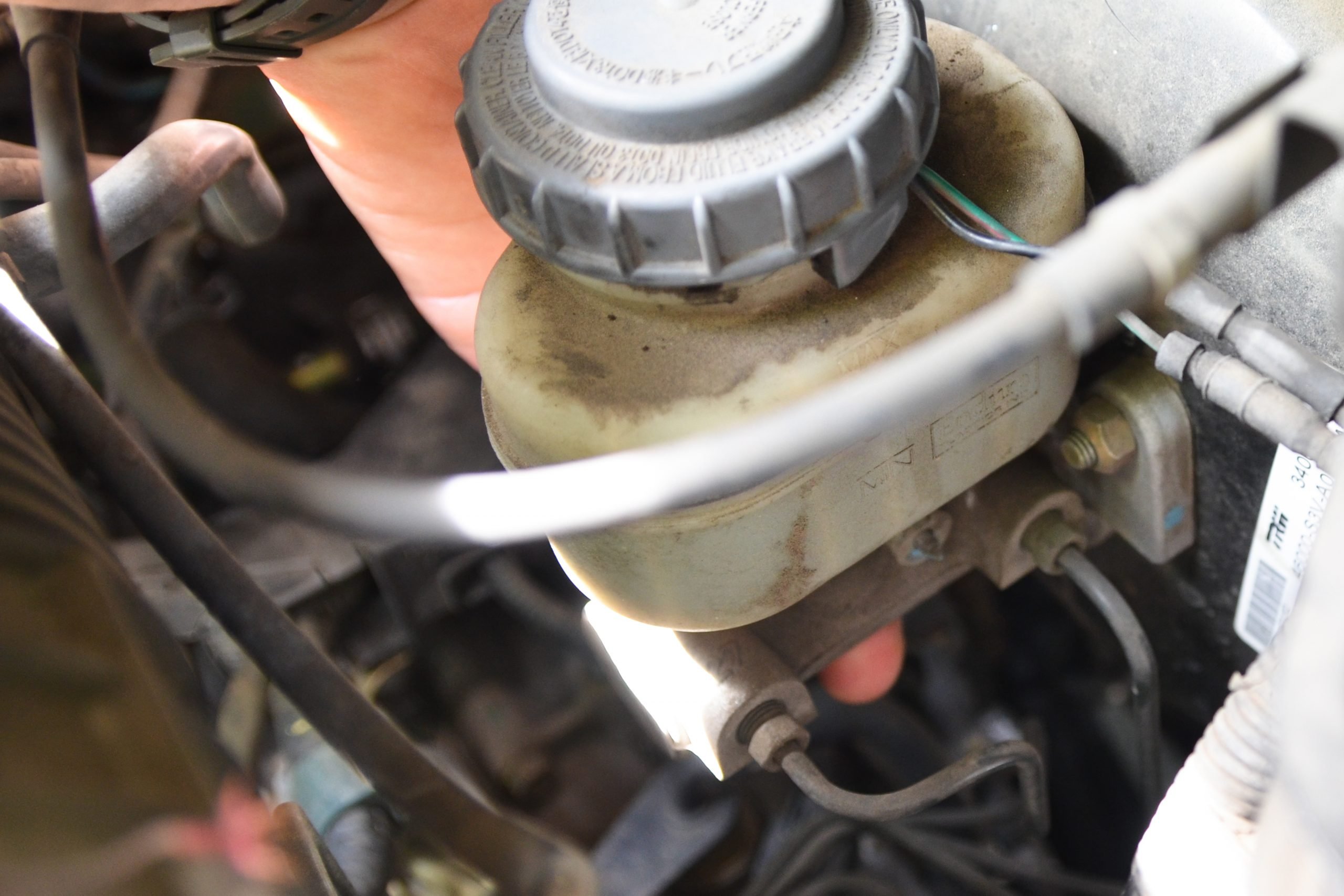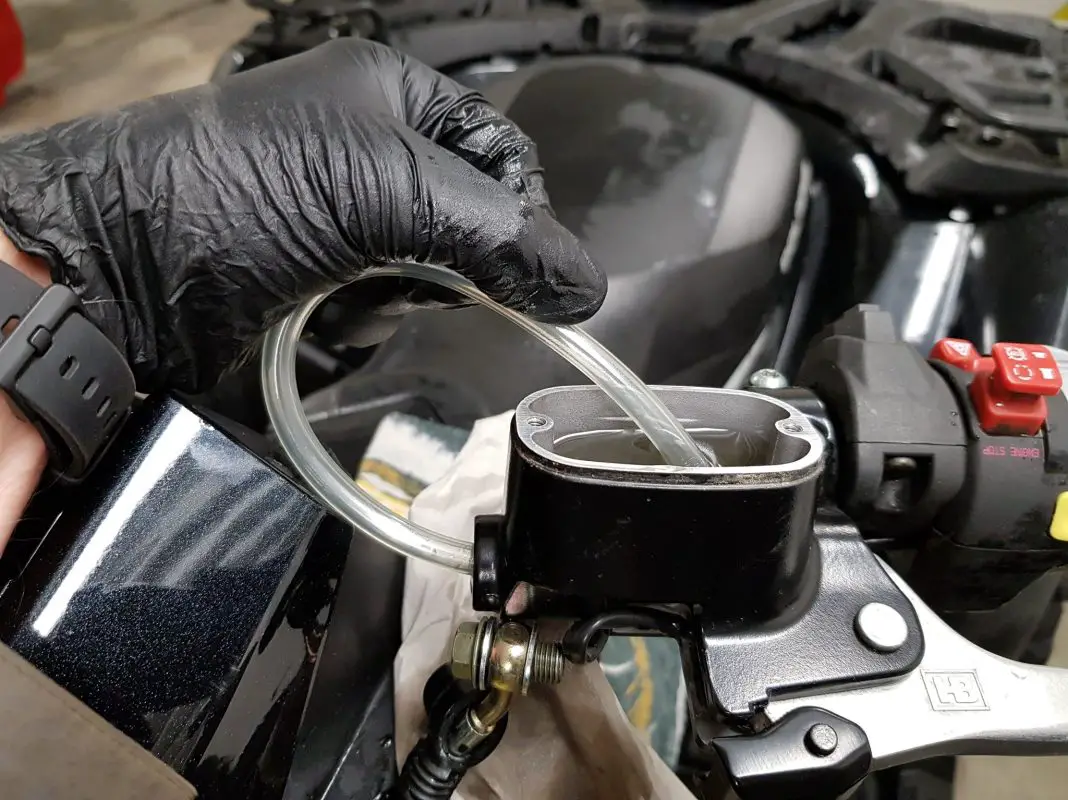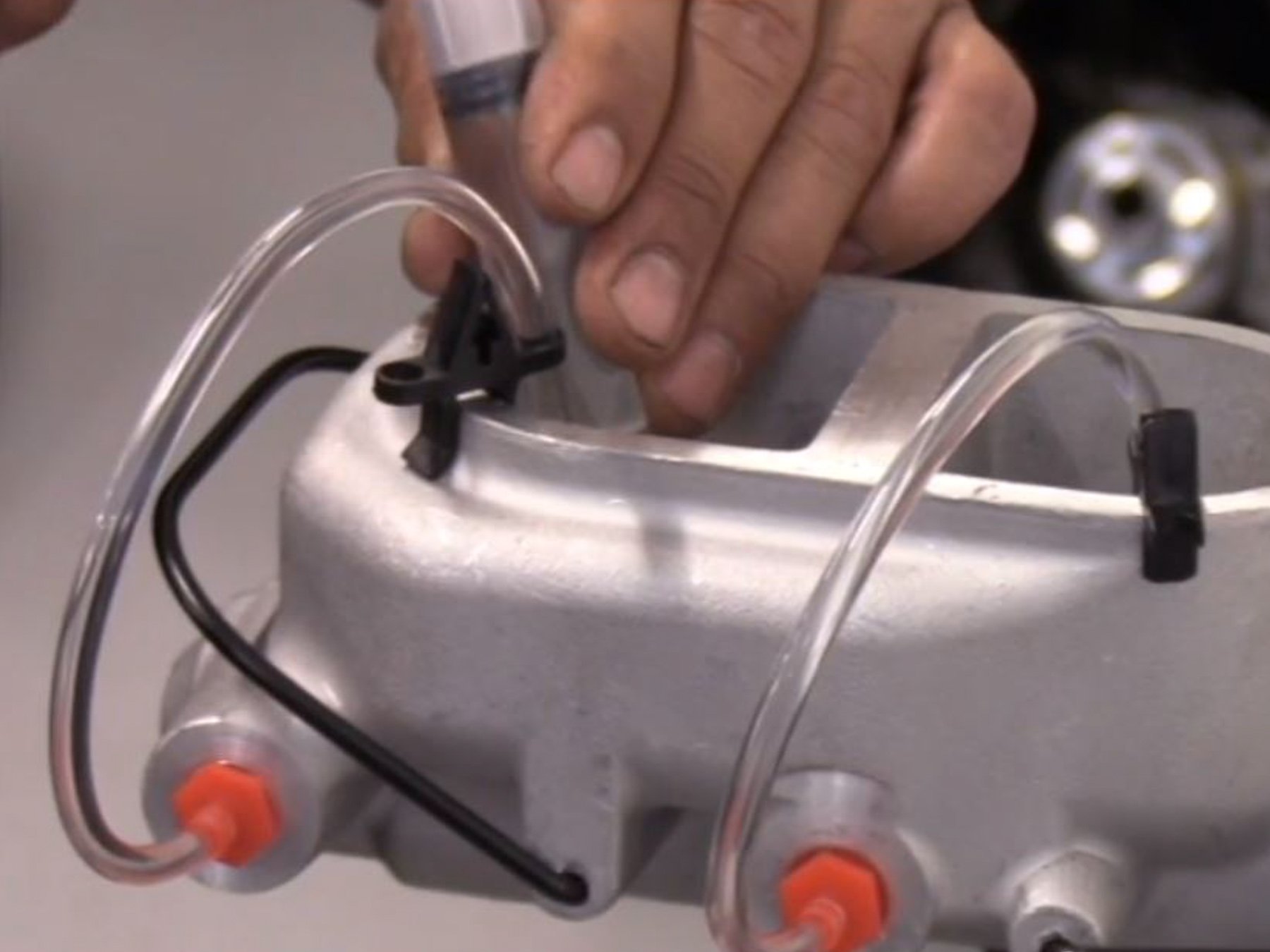Hydraulic System Not Leak Tight
The clutch system is basically a hydraulic circuit, it is very essential that it is leak-free. If the hydraulic circuit is leaking, then it is highly possible that air will find a way into the system.
If the air has entered the system, then in order to efficiently work, it is very necessary that the clutch master cylinder needs to be bleed. Without doing so, proper engagement and disengagement of clutch would not happen. It will also cause rough shifting.
How To Bench Bleed A Master Cylinder Without A Kit
There is an easy way to avoid the need to bleed a master cylinder, even if it seems like it would take forever.
Bench bleeding means bleeding the master cylinder on your workbench, removed from your car.
Installing a new master cylinder requires bleeding your brakes. Otherwise, you’ll need to use the pump-pump method.
Remove the brake fluid cap.
Screw in the bleeder screw until it bottoms out against the vise.
Insert a wooden or plastic dowel into the bleed screw and hold onto it tightly while you turn the bleed screw counterclockwise with your hand.
Bleeding the master cylinder should stop when there is no more fluid coming out of the bleeder screw.
Replace the brake fluid cap before driving your car again to avoid any accidental leaks
Car Bibles Favored Brake Tools
You can buy tools to work on your brake system at almost every auto parts and home improvement store. As well as online stores like Amazon. You have a sea of options to select from. Why even deal with all that uncertainty when you can just listen to us? Such as these bench vises, new brake pads, or brake rotors.
Disclosure: Carbibles.com is also a participant in the Amazon Services LLC Associate Programs, an affiliate advertising program designed to provide a means for sites to earn advertising fees by advertising and linking to Amazon.com. Pages on this site may include affiliate links to Amazon and its affiliate sites on which the owner of this website will make a referral commission.
You May Like: What Car Rental Companies Offer Aarp Discounts
Bleeding Master Cylinder On Car
wolfsdadAm about to replace the 2 lines that feed down from the master cylinder as they got damaged by a falling block and tackle from an overhead hoist Luckily, this seems to be the only damage.I have read posts before about bench bleeding new master cylinders before putting them on the car. I wondered if before the new lines are fitted, I could simply refill cylinder and bleed it using two small pipes that feed back into it by slowly pressing the brake pedal and then refit new lines.Thanks.Posts
Bleeding A Master Cylinder The Master Power Brakes Way

If you are a person that enjoys bleeding a master cylinder, you are a rarity!! The traditional method of bleeding a master cylinder involves a pair of rubber hoses that have to go from the ports on the master cylinder up and into the reservoir. Invariably, as soon as you start the process, one of the hoses pops out and slings brake fluid all over the shop and that is when you wish there was another way.
Well fear not, there is. With every disc brake conversion kit that we sell, we include a Syringe Bleeder Kit . What our kit allows is rather than pulling the fluid through the master cylinder and then feeding it back in over and over, the syringe allows you to inject the fluid into the ports and simply push the air out. Air naturally wants to rise anyways so that is only helping the situation.
To operate, partially fill the reservoirs of the master cylinder and then suck the fluid out using the syringe. Once you have a syringe full of fluid, firmly press the rubber tip against the port location one at a time. In each instance you should slowly inject the brake fluid into the master cylinder. Inside you will see a steady stream of bubbles in the fluid. As you continue the stream of bubbles will turn into a steady stream of fluid. Once this transition occurs that portion of the master cylinder has been bled. repeat this process on other port and you are finished.
Recommended Reading: Where Do I Put Oil In My Car
How To Bench Bleed A Master Cylinder On The Car
To bench bleed a master cylinder, prepare the vehicle and position the hard lines to accept a fully bled master cylinder.
Wilwood offers bleed kits to assist with bench bleeding.
If you’re replacing or installing a master cylinder or performing routine full-bleed procedures, Wilwood has brake fluid to suit your needs.
How To Bench Bleed A Ford Clutch Master Cylinder
During installing a new master cylinder, bench bleeding is necessary to ensure that all air is removed from the master.
Bleeding can be done on your workbench and in your car.
In my pickup, which needed a brake master cylinder, I decided to show how to bench bleed one before installing it.
To bench bleed a Ford clutch master cylinder, you will need:
- A tube of silicone sealant
- A vacuum cleaner with the hose attachment
- An empty oil tank or container
- A funnel
- A crescent wrench or 10mm socket
Remove the cap and fill the oil tank or container with brake fluid. Turn on the vacuum cleaner and attach the hose to it. Pump the brake fluid until it reaches 100 psi . Then pour half of the silicone sealant into the funnel. Depressurize the tube by turning on your vacuum cleaner until all the air has been forced out of it. Then release the brake fluid pressure and pour the remaining silicone sealant into the cylinder. Replace the cap and turn off your vacuum cleaner.
You can bleed a clutch master cylinder by loosening the bleeder screw on top of each clutch disk with a 10mm socket or crescent wrench. Turn it until all four screws are loose, then remove them. Bleed each clutch disk using your funnel to pour brake fluid slowly over one end of the disk while turning it with a wrench. Reinstall everything in reverse order and torque all four bleeder screws to 25-30 ft-lbs .
Recommended Reading: How Much Does The Average Car Salesman Make
Bleed The Master Cylinder With A Hand Pump Tool
If youre not having any success bleeding the master cylinder just by pumping, you can try using a hand pump brake bleeding tool.
Depending on what model you get, these can be used for both pressing brake fluid through the master cylinder or sucking brake fluid down by utilizing vacuum.
The tool comes with a rubber adapter that can be inserted into the outlet hole on the reservoir. Follow the tool directions and press brake fluid back into the master cylinder assembly until no more bubbles appear in the reservoir.
Alternatively, you can switch the tool over to vacuum and suck brake fluid down from the reservoir and into the too through the same outlet port. If this does not help, you likely have a bad master cylinder and need to rebuild it to get it to start pumping again.
S To Bleed The Master Cylinder Without Bench
Which brake do you bleed first? We start bleeding on the brake cylinder that is farthest from the master cylinder on your car. It is easy to understand when the bleeding is complete. The old brake fluid is likely to be dark green while the new one will be clear.
Be careful to keep the brake fluid away from the cars paint be wary of dripping or any residue on your hands. Brake fluid can damage the paintwork of your vehicle.
Various methods are listed below to easily bleed the master cylinder without moving it from the car to the workbench.
Don’t Miss: Does Aaa Ship Cars
The Tools & Parts You Need
A trip to the auto parts store can be a time-suck. Dont spend the day twiddling your thumbs waiting for a package or driving to and from the store.
Get everything the first time, such as: a brake bleeding kit, a length of clear plastic tubing sized to your bleeder valve, a container, a selection of wrenches and screwdrivers, and new brake fluid.
Youll also need a friend, partner, child helper, or very well-trained dog.
How To Bleed The Rear Brake Master Cylinder
The rear brakes on many ATVs will have their own master cylinder. To bleed it properly, it is best to remove it and properly bench bleed it.
Related:ATV brakes wont bleed 9 possible causes.
Read Also: Equus Reliability
Open The Bleeder Valve To Start Purging
Apply firm pressure to the clutch pedal in the cabin of your vehicle. Press down the clutch pedal all the way until it reaches the floor. Use a wrench on the slave cylinder bleeder valve to loosen it up. Keep loosening the valve until air comes out. Moments later, you should start seeing hydraulic fluid bleeding out of that. Make sure you place a container down so that the fluid can fall into it.
Note that it is best to use a flare nut wrench for clutch and brake bleeding. These wrenches are designed to put as much surface area as possible on the bleeder screw so you minimize the chance of stripping the nut.
Top Off Clutch Fluid Reservoir

Have your partner slowly release the clutch pedal until it is returned to its normal position. Go to the master cylinder and open the top of the brake fluid reservoir.
Take your extra hydraulic fluid and pour it into the reservoir until the fluid reaches the Full line. Try not to add so much that it overfills.
Read Also: What Credit Bureau Does Car Dealerships Use
Ensuring No New Air Enters The Clutch Line
How To Bench Bleed A Master Cylinder With Bleeder Screws
Each Wilwood tandem aluminum master cylinder includes fittings and hoses for proper bleed.
Bleeder screws are used to force the air out of the bore of the cylinder, and the ends of the bleeding tubes must remain submerged in brake fluid.
When installing a new master cylinder, insert a depth correction plug.
Then, bleed the system by depressing the bleeder screw until the system is free of air.
If there are leaks, make sure they are repaired.
Reinstall fittings and top off reservoirs.
Install the diaphragm gasket and billet lid.
Tighten screws no more than finger-tight
Use a cross pattern
Bleed the master cylinder
You May Like: How Much Money Does A Car Salesman Make
Top Of The Master Cylinder
Topping off the reservoir in how to bleed clutch master cylinder process is very important. Slowly release the clutch pedal until it is returned to its normal position. Go to the master cylinder and open the top of the brake fluid reservoir. Take your hydraulic fluid and pour it into the reservoir until the fluid reaches the Full line. Try not to add so much that it overfills.
Alternative Method Using The Banjo Bolt As A Bleed Valve
A variation of the above methods is when you, instead of controlling the fluid stream with your finger, use the banjo bolt as a bleed valve.
Step 1 to 4 is identical as above.
5. Then pump the brake lever as you do when manually bleed the brakes.6. But instead of opening the bleed valve by the caliper, you open the banjo bolt until the brake fluid starts sputtering out.
7. Tighten the bolt when the brake lever is about 80% engaged.8. Re-apply pressure and open the banjo bolt again.9. Continue until you get a sputter-free stream of brake fluid.10. Then bleed the brakes normally. You should now be able to build proper pressure.
This method may be a bit messier, so make sure you use plenty of rags to keep your ATV protected.
Related:12 reasons why your ATV brakes wont build or hold pressure.
Don’t Miss: How Much Do New Car Salesmen Make
Do You Have To Bench Bleed A Master Cylinder
Typically, you dont need to do a bench bleed. The techniques we have shown are enough to take the air out of your master cylinder. But when you need to bleed your master cylinder quickly, bench bleeding is the answer. You dont want to spend an hour or half beside the road bleeding your master cylinder. Its dangerous. So in this situation, you may do the bench bleeding. We will tell you how.
How To Bench Bleed A Chevy Master Cylinder
Bleeding the master cylinder before installation is very important to ensure all air has been purged.
Removing all prepackaged contents from the kit and within the master cylinder should be done carefully.
To bleed a Chevy master cylinder, fill the reservoir with brake fluid and a screwdriver and insert bleeding tubes into the ends of the tubes.
Pump air out of the master cylinder with a screwdriver.
Reinstall fittings and top off reservoirs.
Install diaphragm gasket and billet lid with Allen screws
To bleed a Chevy master cylinder, tighten screws in a cross pattern no more than finger-tight.
Bleed the master cylinder by turning the bleeder screw until fluid comes out of the brake pedal.
If you have an ABS, wait 10 minutes before driving to allow the system to reset.
Check your brake fluid level and replace if necessary.
Don’t Miss: Car Air Freshener Making Kit
Why Is It Recommended To Bleed The Master Cylinder On A Bench Vs On The Car
Bleeding the master cylinder on a bench allows you to bleed the system without worrying about damaging the master cylinder or the lines. Bleeding on the car is very dangerous, especially when the car is moving because you cannot see what you are doing.
Master cylinder installation can be difficult if the air is not properly purged from the piston chambers.
To bleed a master cylinder on a bench, it is recommended to place it in a vice and has easy access to the piston chambers.
If the master cylinder is installed at an angle inside an engine compartment, bleeding it on a bench will be futile.
Bleeding the master cylinder on a bench is recommended to prevent air from entering the brake system.
Bleeding the master cylinder on a car is not recommended as it can cause damage to the brake system and other parts of the vehicle.
Bleeding the master cylinder on a bench is recommended to avoid fluid accumulation and damage to components.
How To Bench Bleed A Master Cylinder

Bench bleeding is done with the master cylinder secured in a vice on a workbench. Some new master cylinders come with a bleeding kit, which consists of two clear flexible tubes, a plastic clip for the lines and two plugs pins. The lines connect to one end of the plug pins, which are inserted into the brake fitting holes in the master cylinder. The lines slide into the clip, which secures the lines to the master.
When placing the lines into the bowls of the master cylinder, make sure they go to the bottom. Every time you actuate the piston, it pulls fluid from the bowl and pushes it out the tubes. When the piston is released, it pulls a vacuum on the tubes. If the ends are exposed, they will suck air, negating the work you are doing.
Fill the reservoir bowls with fluid. The level will drop as you operate the piston. Filling it once to full should suffice.
Using a screwdriver, or ratchet extension, slowly push the plunger on the back of the master cylinder in. Make sure it goes all of the way. Slowly release it, letting it return to the closed position. The plunger is spring loaded, so some effort is required to move the piston. Repeat this action.
As you operate the plunger, the tubes will fill with fluid and air bubbles. As you work through the process you will see how difficult this would be if the brake lines were attached.
Once all of the air is out, cap off the lines or if unit had plastic caps, reinstall them into the threads.
Categories
Recommended Reading: Aarp Rental Car Rates
